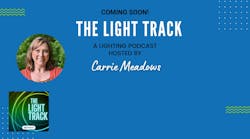Editor’s note: This interview was prompted by an inquiry about whether human-centric lighting can help people adjust better to daylight savings time changes. During the course of our discussion, Lori Brock let me know that the more pertinent opportunities to positively impact the human physiological response to light run more to circadian entrainment on a regular basis, to stabilize the human sleep-and-wake schedule when traveling across time zones, and to provide performance and productivity boosts as a result of stimulation with the right spectrum of light at the appropriate times. As a result, this interview has been edited to the discussion on the overall applications of human-centric lighting and those under study for commercialization rather than focusing on seasonal time shifts.
LEDs Magazine: So today we are going to talk about human-centric lighting. But I just wanted to start with a little perspective on your experience. So how does your research background inform your current role at Osram?
Lori Brock: Good question! Well, I’m currently the head of innovation for the Americas region for Osram. And in this role, we’re responsible for the technology innovation, responsible for the technology backbone of Osram and our future direction. And it’s very broad. We work on lots of different research activities including human-centric lighting applications, new products for human-centric lighting, to answer your question.
LEDs: With regard to that — we’re calling it human-centric lighting… [and] we’re going to continue to go with that as a very broad term, but at LEDs Magazine we kind of expand on the concept a little bit by calling it “lighting for health and wellbeing” so it can include a broad spectrum of things. In what ways right now is Osram active in this field of study?
LB: Well, as you know we collaborate very deeply with the Lighting Research Center and Mariana Figueiro, and other researchers in the topic, who are doing the fundamental research on how light affects the human condition — our biology, our psychology, etc. But then we take that knowledge from the scientific community and we convert it into applications and products for everyday people. And some of the things that we’re launching in the market, for example, are our human-centric lighting eyeglasses that deliver light directly to the retina of people. We’ve tested these on travelers on airplanes and in airports, for example, to help mitigate jet lag. And we work with professional athletes like skiers, swimmers, football players, and racecar drivers to help them use these things to increase their alertness and improve their performance.We’re also bringing to market special lounge chairs that have this lighting built into the chair, so that someone can sit down, at say, an airport lounge or in their home or their office; they get recharged and refreshed during work. So we use the scientific knowledge from the universities and the medical institutes and we translate it into products that people can actually use in their everyday life.
LEDs: In regard to daylight savings time, can we improve the human response to time changes and seasonal shifts? What right now are you involved in — whether research-oriented or commercial - that can address the needs of people who are feeling the seasonal issues with their circadian rhythms?
LB: It’s a minimal impact in the fall. […] I do believe that human-centric lighting can help prepare you to adapt to daylight savings time faster and minimize a lot of negative effects such as not being able to get up in the morning during the spring forward [period], so you can prepare in advance and use human-centric lighting to minimize those effects.
You can also use human-centric lighting techniques like a cup of coffee — increase alertness when you’re feeling tired or sleepy, and this can help you be more productive and be in a better mood in the days following a time change. And you can use the things like the chair or the glasses or even just exposing yourself to natural daylight during the mid-daytime... All those things will definitely help with daylight savings time, especially when you spring forward.
“It’s a 24-hour solution when it comes to human-centric lighting.” — Lori Brock
LEDs: Interesting! So if you had to figure it out right now and you had to take a take a look into the future, from your vantage point, where is human-centric lighting headed? And in your view, how do we get there?
LB: Well, I think in the future, say, 20 years from now, all lighting is going to be human-centric lighting. so lighting will have moved on from using LEDs to save energy to using LEDs to optimize performance — whether the performance is in an office or on an athletic field — I mean, that depends on the application. So I think all of it’s going to be around human design needs, around people, at least in applications with people.
LEDs: I find it very interesting that you zeroed in on that right away because I have heard only one or two times so far in direct conversations and one of them is with a colleague — Bob Steele, who is one of the co-chairs of the Strategies in Light conference. He made a comment about that a couple years ago now. We talked about human-centric lighting and he said, really in my view all lighting is human-centric or will be human centric because we design it for the purposes of various functions or applications in which humans need light. He said if you want to get more detailed into it, eventually more and more of it will be less about illuminating the space and more about how we use the light to have other impacts on the human condition or the built environment. I’m looking forward to seeing how many other people pick up on that thought.
LB: I fully agree! I mean, you have visual perception so lighting has to work for people to be able to see, to illuminate objects in spaces so people can see, but then there’s a whole slew of nonvisual effects of light such as circadian entrainment and a lot of other things that people are beginning to learn about in our biology. And I think that lighting is going to start to — the lighting profession, the lighting professional — they’re starting to pay a lot more attention to these nonvisual effects of light. And in the future, we’re going to have to balance the visual and the nonvisual. That’s what human-centric lighting essentially is. The nonvisual effects of human-centric lighting have nothing to do with the rods and cones in your eyes that enable you to see.
LEDs: Right, so you start out with a with a premise of light quality now over energy efficiency because we’re there. We’ve pretty much established that you can achieve better energy efficiency; you can cut down on carbon emissions when you’re using less electricity; and you can achieve those goals with LED lighting when properly designed and specified for the application. But then from there you probably want to focus on quality of light and where is the light going and are you wasting it; and then from there, like you said, what can you do to impact nonvisual portions of the human experience and human biology? So it’s a really interesting timeline.
LB: Exactly, yes.
LEDs: Is there anything else that you’d like to say about what Osram is doing right now with regard to human-centric lighting or how it’s pushing that towards the future?
LB: I’d say that I think you have the gist of it there, so kind of a high level summary of what we’re doing. I will say that we’re looking into many different application spaces. Everything from healthcare environments to schools and education to office workers to industry settings, like manufacturing halls, and even in the street and roadway environment. It’s not just something that you put in some eyeglasses; it’s kind of a complete solution — it’s a 24-hour solution when it comes to human-centric lighting.
LEDs: I haven’t heard anybody say that yet. That’s a great quote.
LB: I learned that from the Lighting Research Center, from Mariana Figueiro and team. They’re very strong proponents of how it’s your total light dose, over many days, that really influences your health and wellbeing. You can do things with lighting to give you a short boost, for example, with the glasses so that we could shift your peak to the time of your performance. For example, if you have a ski race at 10:00 PM at night, you can use the glasses, say, 10 minutes before to give you the blue light directly to your retina, to the skier, and boost their performance. But for the everyday person, it’s a 24-hour thing, human-centric lighting. It’s part of your overall health and wellbeing, not just the short-term effect.
Get to know our expert
As head of innovation – Americas for Osram, Lori Brock is responsible for leading Osram’s transition from conventional lighting manufacturer to a technology innovator in the lighting market. Brock has a doctorate in physical chemistry from the University of Georgia and has held various research fellowships and technical positions, including in the research labs at Osram. Brock is especially interested in moving lighting applications beyond general illumination into smart cities, mobile devices, autonomous vehicles, human wellbeing, and more.






